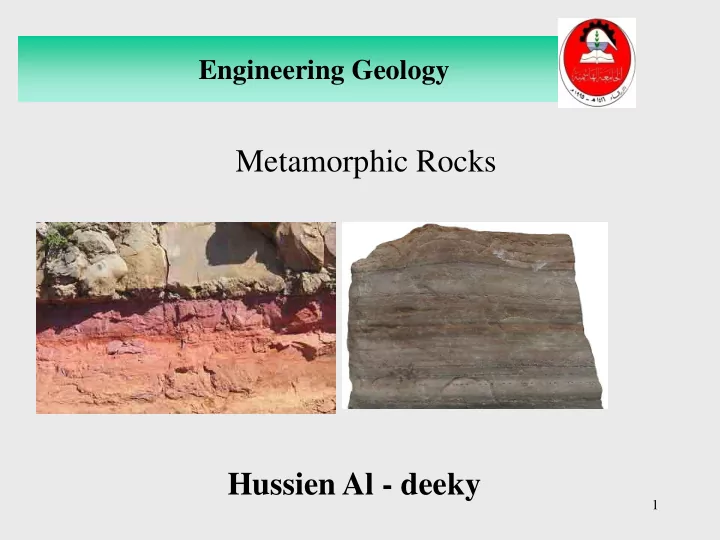

Engineering Geology Metamorphic Rocks Hussien Al - deeky 1
Engineering Geology Definition Metamorphic rock is the result of the transformation of an existing rock type, the protolith ( parent rock ) , in a process called metamorphism, which means "change in form". When the pre-existing rocks (sedimentary or igneous rock) are subjected to increased temperature, pressure and action of chemically active fluids, metamorphic rocks are formed. During metamorphism re-crystallization of mineral constituent takes place, as a result new minerals and new texture are produced. The metamorphic processes generally improve the engineering behavior of these rocks by increasing their hardness and strength. Nevertheless, some metamorphic rocks still can be problematic. Some metamorphic rocks are foliated, which means they have oriented grains similar to bedding plains in sedimentary rocks. These foliation is important because the shear strength is less 2 for stresses acting parallel to the foliation
Engineering Geology for engineering works, and are similar to intrusive igneous rocks in their quality. However, some foliated rocks are prone to slippage along the foliation planes. Schist is the most notable in this regard because of its strong foliation ad the presence of mica. The 1928 failure St.Fancis Dam in California has been partially attributed to shearing in schist and the 1959 failure of Malpasset dam in France to shearing in a schistose gneiss. 3
Engineering Geology 4
Engineering Geology Types of Metamorphism 1-Contact metamorphism (Heat) is the name given to the changes that take place when magma is injected into the surrounding solid rock. The changes that occur are greatest wherever the magma comes into contact with the rock because the temperature are highest at this boundary and decrease with distance from it. Around the igneous rock that forms from the cooling magma is a metamorphosed zone called a contact metamorphism aureole. -shale may become a dark argillaceous hornfels, -Limestone may change to a grey, yellow or greenish lime-silicate-hornfels or siliceous marble , 5
Engineering Geology 6
Engineering Geology 2-Regional metamorphism ( heat &pressure ) is the name given to changes in great masses of rock over a wide area. Rock can be metamorphosed simply by being at great depths below the earth’s surface, subjected to high temperatures and the great pressure caused by the immense weight of the rock layers above. Much of the lower continental crust is metamorphic. 7
Engineering Geology 8
Engineering Geology 9
Engineering Geology 10
Engineering Geology 3-Dynamic metamorphism (pressure) Dynamic metamorphism occurs along fault zones where rocks have been altered by high differential pressure . Rocks formed by dynamic metamorphism are restricted to narrow zones adjacent to faults and are known as Mylonites . Mylonites are commonly hard, dense, fine-grained, and contain thin laminations. 11
Engineering Geology Factors Controlling Metamorphism 1-Heat Most important agent •Two sources of heat – Contact metamorphism – heat from magma – An increase in temperature with depth due to the geothermal gradient 15-30o C increase per km 2-Pressure and differential stress •Confining pressure applies forces equally in all directions; increases with depth •Rocks may also be subjected to differential stress which is unequal in different directions 3-Chemically active fluids •Mainly water with other volatile components •Aids in re -crystallization of existing minerals 4-Sources of fluids – Pore spaces of sedimentary rocks – Fractures in igneous rocks – Hydrated minerals such as clays and micas 12
Engineering Geology the same Protoliths experience different conditions of temperature and pressure, they will yield different metamorphic rocks Heat Basalt Pressure Eclogite Greenschist
Metamorphic Grade High-grade (extreme) metamorphism: radical changes in texture and/or mineral composition of the rock Low Intermediat e High Low-grade (mild) metamorphism: small changes in texture and/or mineralogy of parent rock (200 to 350 OC ) 14
Engineering Geology Rock texture changes 1-Foliation : layering or banded appearance produced by exposure to heat and directed pressure common foliated rock Foliated: Slate • Parallel orientation of grains • Low grade metamorphic, slaty texture • Protolith: shale/mudstone Foliated: Phyllite • Very fine grained mica • Barely macroscopic • Crenulated parallelism, sheen
Engineering Geology Foliated: Chlorite Schist • Mid -grade metamorphic rock • Schistose texture Foliated: Muscovite Schist Foliated: Garnet Schist 16
Engineering Geology Foliated: Gneiss • High grade metamorphic • Gneissic banding: 1 mm to cm’s scale • Protolith: Shale, mudstone, igneous rock Non-Foliated and Foliated: Amphibolite • Coarse grained, high grade • Protolith : Mafic and Ultramafic igneous rocks 17
Engineering Geology Non-Foliated: Marble • CaCO 3 . • Metamorphosed limestone! . Non-Foliated: Quartzite • Metamorphism of sandstone 18
Engineering Geology
Engineering Geology 20
Engineering Geology 21
22
Engineering Geology Engineering Considerations of Metamorphic Rocks ( 1)The metamorphic rocks also have the Alkali-silica reaction problem when used as aggregates with Portland cement. The metamorphic rocks with this problem are argillite, phyllite, impure quartzite, and granite gneiss; (2)Coarse-grained gneiss can be abraded severely when used as aggregates (3)For metamorphic rocks the stability of rock mass greatly affected by the foliation orientation; (4)Marble as a metamorphic rock from carbonate sedimentary rocks can cause similar problems, eg., leakage of reservoirs, sinkhile collapse, solution cavities, and channels 23
Recommend
More recommend